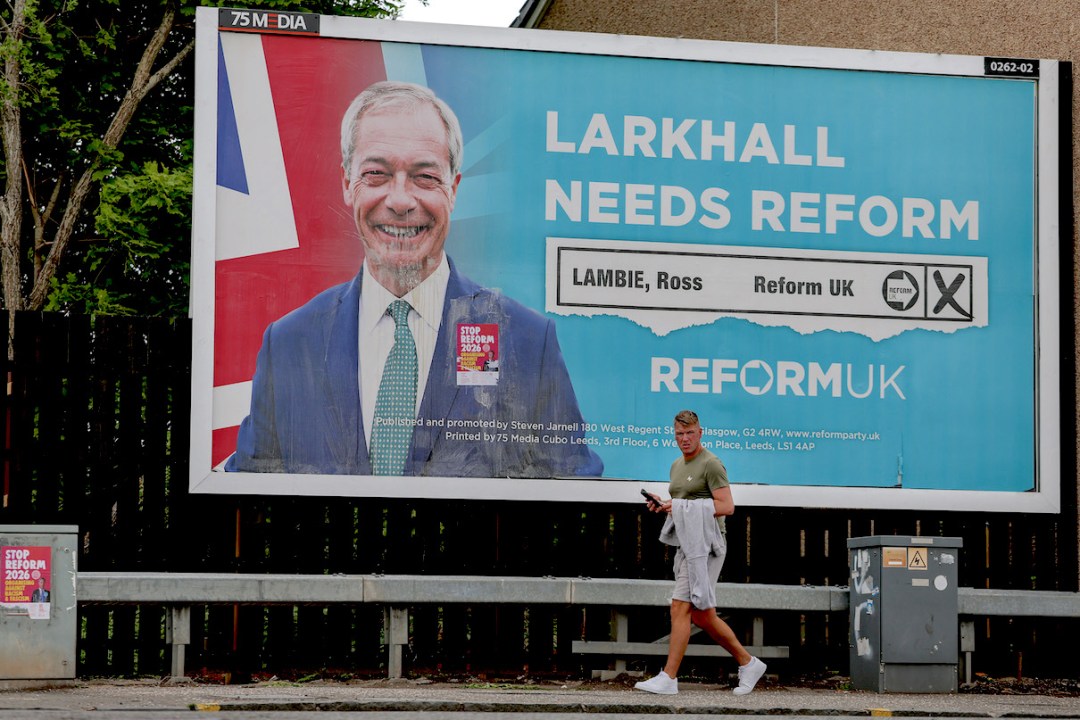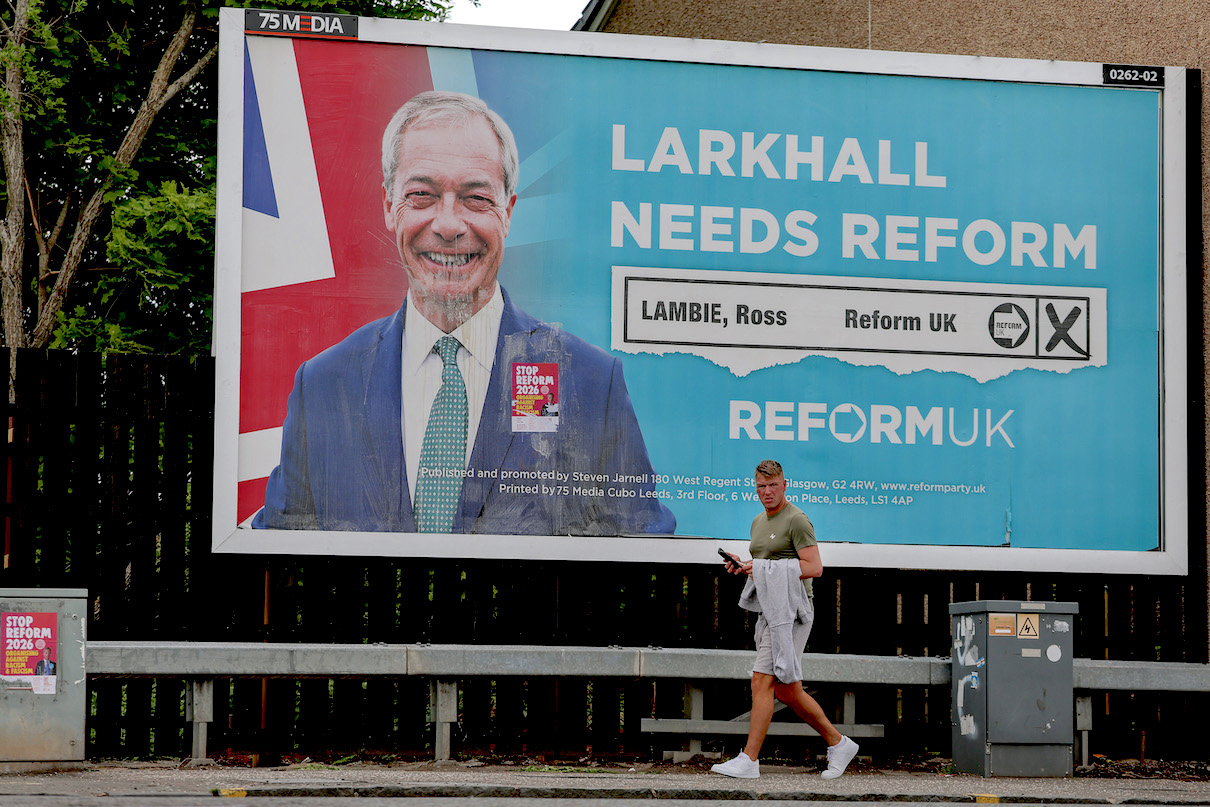There’s not much that’s green in Larkhall, Scotland. So staunchly Protestant unionist is the ex-mining town in South Lanarkshire that it has scrubbed itself of anything associated with Irish Catholicism. The local Subway franchise has grey panelling on its front, and local pharmacies have opted for blue signage. The 15,000-strong area has one football team: Rangers FC. Go deeper into Larkhall’s suburbia and you’ll find Union Jacks on flagpoles interspersed with those bearing the Red Hand of Ulster. Kerbstones have been painted in the colours of the British flag while rumours abound of youths trying to set fire to the grass. ‘In our schools, the wains aren’t taught that traffic lights are red, amber and green,’ one resident chuckled proudly. ‘It’s red, white and blue.’ He was not joking. Some unsuspecting emerald lights were subjected to £17,000 worth of damage many years ago, and they remain boxed off by wire mesh to this day.
It is in this town, as well as in neighbouring Stonehouse and Hamilton, that voters will head to the polls on Thursday 5 June to choose their representative in the Scottish Parliament, following the passing of SNP incumbent Christina McKelvie in March. The first Scottish by-election in six years is just 11 months out from the 2026 Holyrood poll and the result will set the tone for the next year of campaigning.
Each party faces significantly different challenges from the last time voters went to the ballot box. The SNP is on its third leader in as many years, after Nicola Sturgeon – who commanded an impressive personality cult for over a decade – was briefly implicated in an embezzlement scandal. Scottish Labour experienced a brief spell of euphoria after its UK counterparts won a thin supermajority last summer, before remembering that mid-terms never tend to benefit the incumbents. And Nigel Farage’s Reform party has seen a surge in Scotland that has surprised even its own leadership.
In any other year, the constituency would have been Labour’s to lose. The last election result saw McKelvie take 46 per cent of the vote, while her opponent, Labour’s Monica Lennon, was a distant second on 33 per cent. Since then, however, the party of government has dropped about 14 points in the polls, while Scottish Labour has only wobbled by one or two. This would put the two parties neck-and-neck, and after 18 years of SNP rule – never mind the havoc that both Operation Branchform and Humza Yousaf’s leadership wreaked – the reds would have been on course to overturn McKelvie’s 4,500 majority. But with the addition of the unknown quantity that is Reform, there is a widespread but broadly unspoken nervousness in Scottish Labour that their worst fears may soon be realised: that the polls suggesting Farage’s party could become the official opposition in Scotland are accurate.
Reform’s ambitions have grown after a recent run of good news. Pollsters have suggested that Reform could elect around 15 MSPs to Holyrood, making Scottish Labour leader Anas Sarwar’s dreams of becoming first minister less and less likely. But Reform has more to celebrate than projections: a series of recent by-election successes show that the party is gaining traction north of the border. In the Clydebank Waterfront council by-election earlier this month, Farage’s candidate came second to the SNP on 26 per cent of the vote – taking support from both the nationalists and Labour – while the group made gains in council polls across Glasgow at the start of the year. Deputy leader Richard Tice jetted up to Hamilton last week to tell reporters: ‘This is now a two-horse race between the SNP and Reform.’
In Larkhall, he is right to be confident. Here, I find former SNP, Labour and Conservative voters who are all – bar one who won’t vote – backing Farage’s party this time around after feeling let down by the SNP’s lack of delivery and Labour cuts. I meet the Reform-curious George and Cliff in the Village Tavern by the station. (It is frequented, coincidentally, by Sarwar’s cousin – not that this makes the two men any more amenable to Labour.) George, who is a 62-year-old landscaper, tells me of his struggles to find younger employees now. ‘They want to work the system, not come to work,’ he notes cynically, pointing to the generous payouts given to the unemployed and long-term sick. The conversation segues into immigration. Scotland may be facing a population crisis across many of its rural and island towns, but the degree to which Britain’s borders matter in the country’s central belt should not be underestimated. ‘I’m not racist,’ Cliff caveats quickly, ‘but I feel like a minority nowadays when I go into Glasgow.’ George is a little more restrained. He nods to the growing numbers of Turkish barbershops in the area and makes comments about Poles. ‘I’m not fussed as long as they contribute,’ he shrugs.
While Reform is gaining momentum, Labour insists that talk of Farage’s party leapfrogging into second place are overblown
The sense of injustice runs deep. The town has a rich mining history and was once a Labour heartland, but the area has its fair share of deprivation and its hard-working residents feel they’ve been let down by successive governments both north and south of the border. As ever, Keir Starmer’s winter fuel payment cuts provoke a strong response – and despite the Prime Minister’s announcement of a partial U-turn last week, news of the reversal hasn’t permeated much. Now, with both the SNP and Reform promising to ditch the two-child benefit cap and universally reinstate the winter fuel hand-out, Labour finds itself on the back foot. And it’s not just the party’s UK leader that is facing the wrath of Larkhall’s voters: Scottish leader Anas Sarwar inadvertently burnt bridges with the country’s voters after he claimed during a televised general election debate last summer: ‘Read my lips: no austerity under Labour.’ ‘I mean, who is he kidding?’ 59-year-old Cathy snorts incredulously. ‘We’ve had nothing but cuts and tax rises since Starmer came in.’
The working class, unionist elements of Larkhall make it the perfect territory for Farage’s party. In their Hamilton headquarters, Reform organisers show me their ‘war room’: a draughty office tucked away just off the high street kitted out with turquoise merch, colourful flyers and a huge whiteboard across which a blown-up map of the constituency is stretched. Reform’s canvassing material attacks both the SNP’s record in Scotland and Labour’s in Westminster – suggesting, despite Tice’s previous assertion, that the party still sees Sarwar’s crowd as competition. Its candidate Ross Lambie is a former Tory councillor who defected in March – an experience that was dampened slightly when Tice, during interviews with Scottish journalists, forgot both Lambie’s name and the council ward he represented. Voters don’t care about these kinds of oversights though, Lambie assures me when we meet in Hamilton: ‘I’ve had a really positive response on the doors.’ It’s not all been plain sailing, however: Farage and Sarwar remain in a spat over ‘racist’ Reform campaign material that suggested the Scottish Labour leader’s party will prioritise Pakistani constituents.
While Reform is gaining momentum, Labour politicians insist the projections that Farage’s group could leapfrog them into second place are overblown. Deputy leader Jackie Baillie has talked up her candidate’s credentials, pointing out that Davy Russell is well-known in the area and a local success story for Hamilton. This doesn’t explain why the party has rather curiously kept him away from media appearances: Russell announced last week he would not appear in a televised election debate ahead of polling day and he was the only frontrunner not to be interviewed on BBC Radio Scotland. ‘He’s not good on broadcast,’ one insider confided. ‘We’d rather take the hit for not putting him up.’ Scottish Labour’s reluctance to showcase Davy has got some activists privately complaining about why he was picked in the first place. And while Starmer hasn’t been seen in the area, the suggestion that the UK party isn’t fussed about this by-election is immediately shut down. ‘Morgan McSweeney literally lives in the constituency,’ an activist retorts, in a nod to the Labour strategist’s wife being the MP for Hamilton and Clyde Valley.
While the area is of historical significance to the nationalists – it was the 1967 Hamilton by-election that delivered the party its first Westminster MP in the form of Winnie Ewing – and McKelvie was popular among parliamentarians and constituents alike, the SNP’s current candidate is hardly a lucky charm. This will be councillor Katy Loudon’s third shot at contesting an election in two years after she lost the 2023 Hamilton by-election to now-energy minister Michael Shanks and then lost again in 2024. That most pollsters reckon the SNP will clinch victory here is testament to the stickiness of the nationalist vote among pro-independence supporters and the unpopularity of Starmer’s policies, rather than any real political gains made by the party of government.
Ultimately the most interesting feature of this election will be where Reform places – and by how much it will cut into both the SNP and Labour vote. While Reform’s surge north of the border has so far proven beneficial to the SNP, it isn’t in the nationalists’ interest to see the right-wing party gain much more support. For now, it’s the unionists who have most to fear from Farage – but as his group begins to eat into Scotland’s Yessers, the SNP will soon be forced to concede that not even it can hold off the Reform threat for long.









Comments